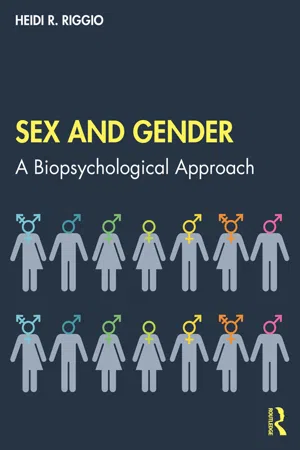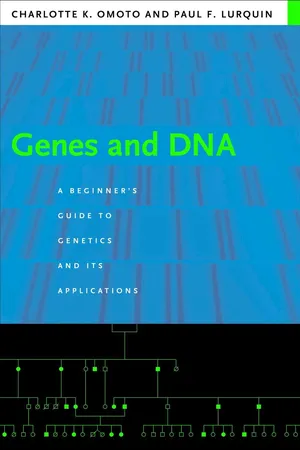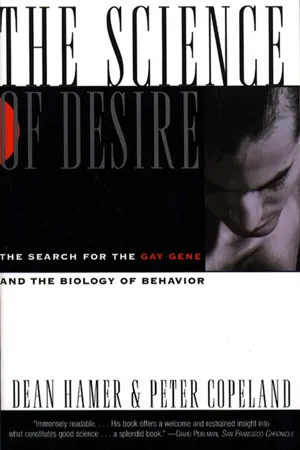Biological Sciences
Sex-Linked Traits
Sex-linked traits are genetic characteristics that are determined by genes located on the sex chromosomes, particularly the X chromosome. In humans, these traits are often associated with X-linked inheritance, where the gene responsible for the trait is located on the X chromosome. This can result in different patterns of inheritance and expression of traits between males and females.
Written by Perlego with AI-assistance
Related key terms
Related key terms
1 of 4
Related key terms
1 of 3
8 Key excerpts on "Sex-Linked Traits"
- eBook - ePub
- Rene Fester Kratz(Author)
- 2017(Publication Date)
- For Dummies(Publisher)
A famous example of co-dominance occurs in human blood type. A person’s blood can be type A, B, O, or AB. Notice how the AB blood type looks like a combination of A and B? That’s exactly what it is. People with type AB blood have one allele for type A blood and one allele for type B blood. Both alleles cause cells to put certain carbohydrates on the surfaces of red blood cells, so a person with AB blood has both carbohydrate A and carbohydrate B on his blood cells. The two alleles are co-dominant to each other so both show up in the phenotype. (In case you’re curious, the O allele is a nonfunctional allele that doesn’t put any carbohydrates on red blood cells. Both the A and B alleles show simple dominance to the O allele. A person with type A blood can have either two A alleles or an A and an O allele, just like a person with type B blood can have either two B alleles or a B and an O allele. A person with two O alleles has type O blood.)Boys vs. girls: Sex-linked inheritance
The inheritance of almost all our genes is exactly the same for males and females. When it comes to the genes on the sex chromosomes, though, sometimes one sex has an advantage over the other. That’s because females get two X chromosomes, while males get an X and a Y. The X chromosome is a long chromosome with lots of genes on it, while the Y chromosome is very short and has far fewer genes. (You can flip back to Chapter 6 and check out the picture of a karyotype in Figure 6-4 .)If a gene for a trait is on one of the sex chromosomes, the trait is called a sex-linked trait.Because females get two X chromosomes, they get two copies of every gene that’s located on the X chromosome, whereas males only get one. The genes on the X chromosome aren’t about being female — they’re genes for important traits, including some that affect muscle and nerve development, vision, and blood clotting. If a girl inherits a defective copy of one of these genes from one of her parents, she can still have normal physiology if she gets a normal copy of the gene from her other parent. But boys don’t have that extra insurance. If they get a defective copy of a gene on their X chromosome, they may show abnormal physiology. When you look at the inheritance of these traits in families, you see that they show up far more often in males than in females. A famous example is the disease hemophilia, which spread through the royal families of Europe. Another example is red-green color blindness.If a gene for a trait is on the X chromosome, the trait is called an X-linked trait. Because males only get one X chromosome, they’re more likely to show abnormalities in these traits.So far, scientists have only identified about three dozen genes on the Y chromosome. The traits pass from fathers to sons. The most famous gene on the Y chromosome is the one that turns on maleness. This gene activates in a male fetus at about six weeks of life. It makes a protein that acts as a master switch, turning on many genes on other chromosomes that all work together to build the male reproductive system and male characteristics. Without a Y chromosome, and without this gene, a fetus develops into a female. - eBook - ePub
- Gail Anderson(Author)
- 2019(Publication Date)
- CRC Press(Publisher)
When things are linked in this way, a gene that is very advantageous to the organism will be selected for, and along with it, it might carry some other genes that just happen to be closely linked. This is often the reason that certain genes seem to stay in the population, although they do not confer an advantage. They are closely linked to genes that do confer an advantage, and so, when those are selected for, they just sort of tag along. It also explains why some quite bad genes, such as those that cause certain diseases, remain. The desired gene outweighs the bad effects and is still selected.Sex-Linked Traits
Of the 46 chromosomes that a human being possesses, one pair (two chromosomes) is the sex chromosomes. The female has two X chromosomes and the male has one X and one Y chromosome. When eggs are produced, one sex chromosome goes to each egg. A female can only provide an X for the eggs. The male, however, has both an X and a Y, so a sperm might carry either one. The egg with which it meets up will be carrying an X, so the sex of the offspring is determined entirely by the male and depends on whether the sperm that he contributes carries an X or a Y. Thus, although Henry VIII beheaded and divorced wives because they did not produce sons, the sex of the child depends on the male, not the female. Certain characteristics of the female reproductive system can favor a sperm that carries a Y or an X chromosome, meaning that the female may have some influence on the sex of the offspring, but sex is primarily determined by the male.The X and Y chromosomes not only determine sex but also carry other genes. The X chromosome is quite large and carries many genes, but the Y chromosome is very small and carries only a few genes. If a gene is on a sex chromosome, it is said to be sex linked. Usually, this means that it is on the X chromosome, simply because it has more genes. We know about a few such sex-linked genes, and some cause diseases in humans. We know the most about genes that cause diseases, because they are of most interest to us. Genes that are involved in hair or eye color are not so vital and therefore do not get the same research attention. Two classic examples of sex-linked conditions are color blindness and hemophilia.2 - eBook - ePub
Sex and Gender
A Biopsychological Approach
- Heidi R. Riggio(Author)
- 2020(Publication Date)
- Routledge(Publisher)
Human beings have 46 chromosomes organized into 23 pairs, with one of each pair inherited from mothers, and the other pair member inherited from fathers. Chromosomes contain genes, with different versions of the same gene called alleles. Some alleles are dominant (they will always be expressed in the phenotype, even with only one allele present), while others are recessive (two alleles, one inherited from each parent, are required for the phenotype to be expressed). Which alleles a person possesses is called their genotype; how the gene is expressed in the person’s appearance or behavior is called the phenotype. Simple inheritance involves only two alleles; such traits as finger length and hair line are determined through simple inheritance. Many traits however involve polygenic inheritance, or more than one pair of alleles. Some traits are sex-linked because genes for those traits are carried on the X or the Y chromosome (the sex chromosomes). Sex-Linked Traits include color blindness and disorders like muscular dystrophy (MD) and hemophilia, all of which are affected by genes on the X chromosome. Because boys and men only possess one X chromosome, if the disordered allele is present they will show the disorder and the disorder will be more common in male births. Other genetic disorders are carried on the autosomes (chromosomes not involved in sex determination) and can be dominant or recessive. Autosomal dominant disorders included Marfan Syndrome, Neurofibromatosis, and Huntington’s Disease. Autosomal recessive disorders include cystic fibrosis (CF), Tay Sachs Disease, and albinism. Modern research indicates that epigenetic effects (effects of the environment on which genes are active or inactive within an individual) can be linked with prenatal environmental trauma and lifestyle. - eBook - ePub
Sex Itself
The Search for Male and Female in the Human Genome
- Sarah S. Richardson(Author)
- 2013(Publication Date)
- University of Chicago Press(Publisher)
29 For their part, cytogeneticists favored insects and plants. With their rapid generations, small sets of chromosomes, and simple binary traits, they were perceived as far more tractable for laboratory research than humans.Nonetheless, scientists knew that humans had sex chromosomes, and they did not refrain from speculating about what the X and Y meant for human sex differences.30 The sex chromosomes found their way into broader discourses around gender, discourses often framed by the expectation that the facts of biology would help to settle the matter of the hierarchy of the sexes once and for all. Most of the focus was on the implications of an extra X chromosome in females and a single X chromosome in males, but scientists also engaged spirited debate about the connection between the Y and maleness.“Sex is quantitatively determined by the X chromosome. . . . [T]wo X’s determine a female and one a male,” wrote Morgan and Bridges in 1916, concisely summarizing the view of chromosomal sex determination that would stand until the 1950s. In the first half of the twentieth century, cytologists believed that the X determined sex and that the Y was a chromosomal fragment of little genetic importance. Wilson described the Y chromosome as merely a “supernumerary” “without significance in sex production.” Guyer asserted that “the existence of the [Y-element] seems to be a wholly capricious one, at least as far as sex production is concerned.” And Stevens wrote that “the indications are that the chromosome Y is of no hereditary value.”31 - eBook - ePub
Medical Genetics E-Book
Medical Genetics E-Book
- Lynn B. Jorde, John C. Carey, Michael J. Bamshad(Authors)
- 2019(Publication Date)
- Elsevier(Publisher)
5Sex-Linked and Nontraditional Modes of Inheritance
The previous chapter dealt with diseases that are inherited in patterns that were first elucidated by Gregor Mendel. In this chapter we discuss disease-causing mutations that are inherited in ways that were unknown to Mendel and are thus sometimes termed nonmendelian.The first mutations to be discussed are DNA variants of the sex chromosomes (X and Y), known as sex-linked mutations. The human X chromosome is large, containing about 5% of the nuclear genome’s DNA (approximately 155 million base pairs [155 megabases, 155 Mb]). Nearly 1300 genes have been localized to the X chromosome, and the diseases caused by these genes are said to be X-linked. In contrast to the X chromosome, the Y chromosome is quite small (60 Mb) and contains only a few dozen genes.Another group of disease-causing mutations is located in the mitochondrial genome, which is inherited only from one’s mother. Mitochondrial diseases thus display a unique pattern of inheritance in families. Extensive analyses have revealed a growing number of disease-causing mutations in the mitochondrial genome.Finally, we discuss two processes that have been elucidated only in the past two to three decades: anticipation and imprinting. Anticipation refers to earlier age-of-onset of some genetic diseases in more recent generations of families. Imprinting refers to the fact that some genes are expressed only on paternally transmitted chromosomes and others are expressed only on maternally transmitted chromosomes. Our understanding of both of these processes has been greatly enhanced by detailed molecular analyses of humans and model organisms.X. Inactivation
The X chromosome contains many important protein-coding genes, and it has long been known that human females have two X chromosomes and males have only one. Thus females have two copies of each X-linked gene, and males have only one copy. Yet males and females do not differ in terms of the amounts of protein products (e.g., enzyme levels) encoded by most of these genes. What could account for this? - eBook - ePub
Genes and DNA
A Beginner's Guide to Genetics and Its Applications
- Charlotte Omoto, Paul Lurquin(Authors)
- 2004(Publication Date)
- Columbia University Press(Publisher)
chapter 2 , one such trait is eye color in fruit flies. In humans, as in fruit flies, females have XX sex chromosomes, and males have XY sex chromosomes. Scientists have discovered that the X chromosome carries many more genes than the Y chromosome and the Y chromosome is very small.Hemophilia in humans is a classic example of a Mendelian trait that resides on the X chromosome. Individuals with hemophilia suffer excessive bleeding caused by the inability of their blood to clot. Like many diseases, however, hemophilia exists in different forms. There are actually three different diseases categorized as hemophilia. Two of those forms, called hemophilia A and hemophilia B, are due to defects in genes located on the X chromosome.Figure 3.1 Differences Between Blood Types. A simplified diagram of the difference between A, B, and O blood types showing the differences in the surface sugars of red blood cells. The O blood type (top) has a set of sugar molecules shown as dashes. The other blood types have an additional sugar attached. A person with two copies of the A or B blood type gene is indistinguishable from someone with an A and an O sugar, and vice versa with the B blood type. An AB individual has both an A-type sugar and a B-type sugar. This diagram greatly exaggerates the size of the sugar molecules with respect to cell size. In reality one would not be able to see the sugars even under a microscope.Let us see how the pattern of inheritance is affected when a gene is located on the X chromosome. The classic example from history is that of Queen Victoria of Great Britain and her descendants. Queen Victoria was a carrier of hemophilia. This means that she had one normal copy of the blood clotting gene and one defective copy. The form of the gene responsible for the hemophilia trait is recessive to the normal gene, so Queen Victoria did not show any symptoms of the disease. Her husband, Prince Albert, did not exhibit the disease either. Males have an X and a Y chromosome and the Y chromosome does not carry the genes for blood clotting at all. Since recessive traits on the X chromosome of males are expressed because there is not another X chromosome to mask a recessive trait, he could not have carried the hemophilia gene. - eBook - ePub
Science of Desire
The Gay Gene and the Biology of Behavior
- Dean Hamer(Author)
- 2011(Publication Date)
- Touchstone(Publisher)
What Morgan had discovered is that the genes for eye color and body color in fruit flies are “linked.” Genes for both traits are located on the same piece of DNA on the same chromosome, and since pieces of DNA usually are passed whole from one generation to the next, eye color and body color always are inherited together. When traits are linked, one can be used to help track the other. Finding enough links enables geneticists to draw maps showing where genes are located.Linkage analysis in humans is based on two fundamental principles of genetics. First, if a gene influences a trait, then individuals who share the same form of the gene have a good chance of sharing the same form of the trait. This applies to unrelated people, but the influence of a particular gene usually is most obvious in close relatives, such as brothers. That is because in some cases the gene will only work with other genes or in a particular environment, conditions shared more often by close relatives. In other words, if a gene must interact with another gene or only expresses itself in a certain environment, the person most likely to share the second gene and the environment is a close relative, such as a sibling.The second principle that influences linkage is that genes found close to one another on a chromosome usually are inherited together. Because of simple chemistry, two genes that are “close together” are, by definition, found on the same DNA molecule. DNA is tough and wiry; only rarely do its long strands break in two. As a result, genes that are located on the same piece of DNA almost always travel together into the germ cells that make up the fertilized egg.From these two principles emerges a third. If a trait really is influenced by a gene, then people who share the trait have a good chance of sharing a piece of DNA close to the gene. Conversely, if no gene exists, then there is unlikely to be a shared piece of DNA This means linkage can be used not only to map genes but also to determine whether or not a gene even exists.A good way to understand this is with the simple example of color blindness, a trait that follows Mendel’s laws. Color blindness is controlled by a recessive gene located on the X chromosome. In fig. 4, the black squares represent color-blind men, and the white squares and circles represent men and women who can distinguish colors. - eBook - ePub
- Vernon A. Rosario, M.D., Vernon A. Rosario, M.D.(Authors)
- 2013(Publication Date)
- Routledge(Publisher)
Another powerful strategy to identify genetic components in behavior is the cross-fostering study. Traits known to pass down the generations can be identified in children adopted away from their biological parents. Both the adoptive and biological parents must then be assessed. If the trait is found more often in the adoptive parents, cultural transmission is implicated; if in the biological parents, a genetic influence is suggested. The study of half-siblings also helps to identify traits carried in the maternal versus the paternal line. Cross-fostering studies are labor intensive, and so far, none has been done for sexual orientation.Gene Linkage
The research strategies so far mentioned may be useful to judge whether a given trait has a probability of being genetically transmitted, and perhaps something can be guessed about the nature of the gene, whether dominant or recessive, sex-linked or autosomal, highly penetrant or not. But family studies neither implicate a particular gene nor define its mode of action. Molecular biologists now have the means to locate a gene using linkage with gene markers. Linkage is simply a statistical relationship between a stretch of polymorphic DNA (a marker) and a physical or psychological trait of interest to the researcher. DNA is obtained in blood samples from informative family members, gay brothers for example. The marker can be any piece of DNA that is sufficiently variable from person to person; pieces of DNA that are the same in everybody cannot, of course, be informative as markers. The task is to sort through hundreds (or thousands) of markers to find those the gay brothers share and, ideally, that heterosexual brothers do not share. Two brothers, gay or not, will share a lot of markers, a random half of them in fact, but when gay brother pairs are cumulated, the researcher may discover “hot spots”: DNA segments that the gay brothers have in common more often than chance predicts. Heterosexual brothers are useful too in that they ought not
Index pages curate the most relevant extracts from our library of academic textbooks. They’ve been created using an in-house natural language model (NLM), each adding context and meaning to key research topics.
Explore more topic indexes
Explore more topic indexes
1 of 6
Explore more topic indexes
1 of 4







